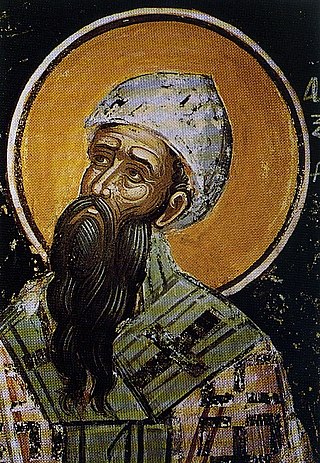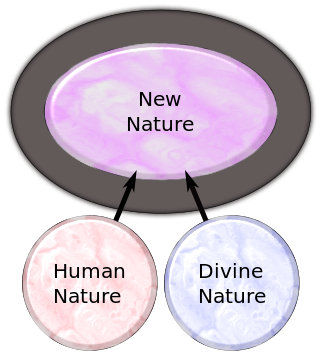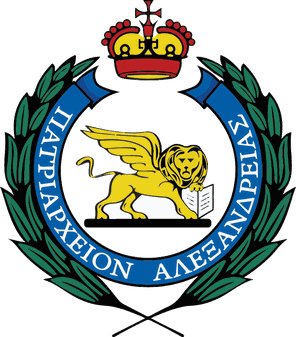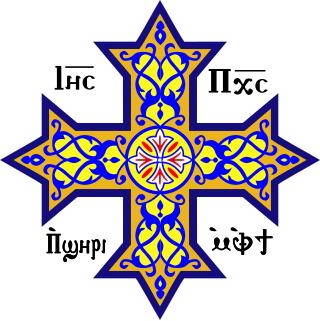Apollinarism or Apollinarianism is a Christological heresy proposed by Apollinaris of Laodicea that argues that Jesus had a human body and sensitive human soul, but a divine mind and not a human rational mind, the Divine Logos taking the place of the latter. It was deemed heretical in 381 and virtually died out within the following decades.
The Chalcedonian Definition is the declaration of the dyophysitism of Christ's nature, adopted at the Council of Chalcedon in AD 451. Chalcedon was an early centre of Christianity located in Asia Minor. The council was the fourth of the ecumenical councils that are accepted by Chalcedonian churches which include the Catholic and Orthodox churches.

Cyril of Alexandria was the Patriarch of Alexandria from 412 to 444. He was enthroned when the city was at the height of its influence and power within the Roman Empire. Cyril wrote extensively and was a major player in the Christological controversies of the late-4th and 5th centuries. He was a central figure in the Council of Ephesus in 431, which led to the deposition of Nestorius as Patriarch of Constantinople. Cyril is counted among the Church Fathers and also as a Doctor of the Church, and his reputation within the Christian world has resulted in his titles Pillar of Faith and Seal of all the Fathers. The Nestorian bishops at their synod at the Council of Ephesus declared him a heretic, labelling him as a "monster, born and educated for the destruction of the church".
Nestorianism is a term used in Christian theology and Church history to refer to several mutually related but doctrinarily distinct sets of teachings. The first meaning of the term is related to the original teachings of Christian theologian Nestorius, who promoted specific doctrines in the fields of Christology and Mariology. The second meaning of the term is much wider, and relates to a set of later theological teachings, that were traditionally labeled as Nestorian, but differ from the teachings of Nestorius in origin, scope and terminology. The Oxford English Dictionary defines Nestorianism as:
"The doctrine of Nestorius, Patriarch of Constantinople, by which Christ is asserted to have had distinct human and divine persons."

The Council of Ephesus was a council of Christian bishops convened in Ephesus in AD 431 by the Roman Emperor Theodosius II. This third ecumenical council, an effort to attain consensus in the church through an assembly representing all of Christendom, confirmed the original Nicene Creed, and condemned the teachings of Nestorius, Patriarch of Constantinople, who held that the Virgin Mary may be called the Christotokos, "Christ-bearer" but not the Theotokos, "God-bearer". It met from 22 June to 31 July 431 at the Church of Mary in Ephesus in Anatolia.
Monophysitism or monophysism is a Christological doctrine that states that there was only one nature—the divine—in the person of Jesus Christ, who was the incarnated Word. It is rejected as heretical by the Catholic Church, Eastern Orthodox Church, Anglicanism, Lutheranism and all mainstream Protestant denominations, which hold to the dyophysitism of the 451 Council of Chalcedon- as well by Oriental Orthodoxy, which holds to miaphysitism.

Nestorius was an early Christian prelate who served as Archbishop of Constantinople from 10 April 428 to August 431. A Christian theologian from the Catechetical School of Antioch, several of his teachings in the fields of Christology and Mariology were seen as controversial and caused major disputes. In 431, he was condemned and deposed from his see by the Council of Ephesus, presided over by his archrival Cyril of Alexandria, but the counter-council led by John I of Antioch vindicated him and deposed Cyril in return. Nestorius refrained from attending both of these councils and instead sought retirement from the Byzantine Emperor.
John I of Antioch was Patriarch of Antioch (429–441). He led a group of moderate Eastern bishops during the Nestorian controversy. He is sometimes confused with John Chrysostom, who is occasionally also referred to as John of Antioch, though John of Antioch is indeed mentioned in the Book of the Miracles of the Blessed Virgin Mary. John gave active support to his friend Nestorius in the latter's dispute with Cyril of Alexandria. In the year 431, he arrived too late for the opening meeting of the First Council of Ephesus. Cyril, suspecting John of using procrastinating tactics to support Nestorius, decided not to wait and convened the council without John and his supporters, condemning Nestorius. When John reached Ephesus a few days after the council had begun, he convened a counter-council that condemned Cyril and vindicated Nestorius.

Cyril Lucaris or Kyrillos Loukaris was a Greek prelate and theologian, and a native of Candia, Crete. He later became the Greek Patriarch of Alexandria as Cyril III and Ecumenical Patriarch of Constantinople as Cyril I. He has been said to have attempted a reform of the Eastern Orthodox Church along Calvinist Protestant lines. Attempts to bring Calvinism into the Orthodox Church were rejected, and Cyril's actions, motivations, and specific viewpoints remain a matter of debate among scholars. Cyril is locally venerated as a hieromartyr in the Alexandrian Orthodox Church; the Holy Synod of the Patriarchate of Alexandria glorified Loukaris on 6 October 2009, and his memory is commemorated on 27 June.
The Patriarch of Antioch is a traditional title held by the bishop of Antioch. As the traditional "overseer" of the first gentile Christian community, the position has been of prime importance in Pauline Christianity from its earliest period. This diocese is one of the few for which the names of its bishops from the apostolic beginnings have been preserved. Today five churches use the title of patriarch of Antioch: one Eastern Orthodox ; one Oriental Orthodox ; and three Eastern Catholic.
Hypostatic union is a technical term in Christian theology employed in mainstream Christology to describe the union of Christ's humanity and divinity in one hypostasis, or individual personhood.
Miaphysitism is the Christological doctrine that holds Jesus, the Incarnate Word, is fully divine and fully human, in one nature (physis). It is a position held by the Oriental Orthodox Churches. It differs from the Dyophysitism of the Catholic Church, Eastern Orthodox Churches, and the major Protestant denominations as defined by the Council of Chalcedon in 451, which holds that Jesus is one "person" in two "natures", a divine nature and a human nature.

Eutychianism, also known as Real Monophysitism, refers to a set of Christian theological doctrines derived from the ideas of Eutyches of Constantinople. Eutychianism is a monophysite understanding of how the human and divine relate within the person of Jesus Christ, with Christ being in one nature and of two, with the humanity of Christ subsumed by the divinity.
Prosopon is a theological term used in Christian theology as designation for the concept of a divine person. The term has a particular significance in Christian triadology, and also in Christology.
African theology is Christian theology from the perspective of the African cultural context. It should be distinguished from black theology, which originated from the American and South African context and is more closely aligned with liberation theology. Although there are ancient Christian traditions on the African continent, during the modern period Christianity in Africa was significantly influenced by western forms of Christianity brought about by European colonization.

The Greek OrthodoxPatriarchate of Alexandria and all Africa, also known as the Greek Orthodox Church of Alexandria, is an autocephalous patriarchate that is part of the Eastern Orthodox Church. Its seat is in Alexandria, and it has canonical responsibility for the entire African continent.

Dyophysitism is the Christological position that Jesus Christ is one person of one substance and one hypostasis, with two distinct, inseparable natures: divine and human. It is accepted by the majority of Christian denominations, including the Catholic Church, Eastern Orthodox Churches, Anglicanism, Methodism, Reformed Christianity and Lutheranism. It was rejected by the Oriental Orthodox churches, who held to Miaphysitism – however they too condemned the converse position of Monophyisitism as a heresy alongside the rest of mainstream Christianity.

Coptic history is the part of the history of Egypt that begins with the introduction of Christianity in Egypt in the 1st century AD during the Roman period, and covers the history of the Copts to the present day. Many of the historic items related to Coptic Christianity are on display in many museums around the world and a large number is in the Coptic Museum in Coptic Cairo.
Catholic dogmatic theology can be defined as "a special branch of theology, the object of which is to present a scientific and connected view of the accepted doctrines of the Christian faith."

Donald Fairbairn is a scholar specializing in patristic soteriology and Cyril of Alexandria who currently teaches at Gordon-Conwell Theological Seminary.








